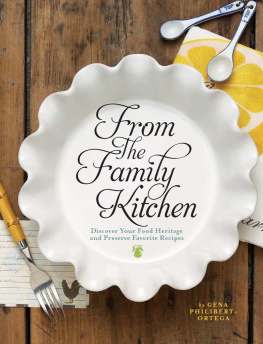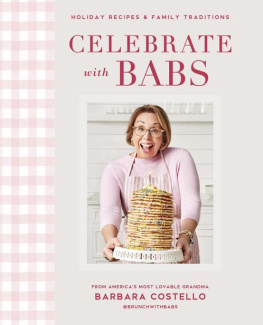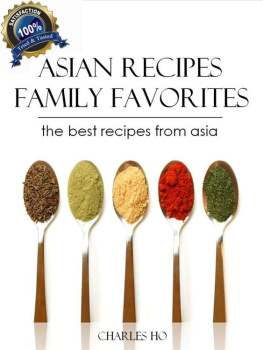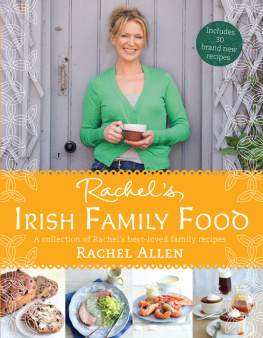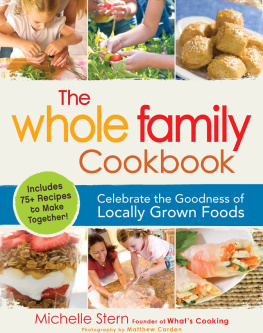Introduction
F ood. I know what youre thinking: What does food have to do with genealogy? For me, the real question is why doesnt everyone include food traditions in their family history?
I have always loved genealogy. As a child I listened to my maternal grandmother talk about her life and the lives of her ancestors, and I have been listening to the stories told by family members ever since. I was one of those kids who would rather eavesdrop on adults as they reminisce than go out and play with my peers. Stories about the stuff of everyday life are so vital to genealogy. The everyday lives of our ancestors are exciting to hear about; the names and dates on charts, not so much. Whats more everyday than food? Thats why food is essential to genealogy.
Ive also always been interested in the lives and roles of women throughout history. Most genealogists have trouble tracing female ancestors. Lets face it, womens history researchers have been writing for decades that women are overlooked by historians. Their lives are often relegated to the home. They lose their identity upon marriage and subsequent marriages when they change their surnames. Its not uncommon to look at a death certificate and in the place reserved for the name of the mother of the deceased there is the word unknown.
As I started teaching about ways to research female ancestors, it occurred to me that instead of feeling frustrated that women dont always appear in traditional genealogical resources, we should be looking at activities women participated in and how those activities left records of womens lives. In addition, we should be enhancing our research with social history. Social history tells us what life was like for everyday people during certain time periods. Just as many of us remember what we were doing when President John F. Kennedy was shot, the activities of our ancestors days influenced their lives.
Now, dont get me wrong, this is not a book solely about researching female ancestors. Everyone eats, and children and husbands help prepare family meals. But the tools found in this book can help you round out the research on your foremothers.
Along with genealogy, Ive always been interested in food. Not just in the eating of food but in what other people eat, how they prepare it, and the history behind it. Ever since I received TheNancy Drew Cookbook when I was a young girl, Ive been fascinated with how food tells a story.
My love of food crops up even now. One of my favorite types of Facebook posts is when people add photographs on their Facebook walls of what they had to eat. My family and friends have been known to send me photos of what they just ordered at a restaurant or their latest creation. This hunger, excuse the pun, probably stems back to my parents, who would go out to eat when I was a child and bring me back the empty shells and crab claws from their dinners. This was truly exciting to me, imagining all of the different types of food people enjoyed. Eating is such a seemingly mundane, ordinary experience, but it really isnt. Anyone who travels gets a sense of how food is different depending on where you live. And thats not taking into account other factors like ethnicity, religion, taste, and family influence. Thats what this book is about. The seemingly everyday act of eating provides us with information to preserve our present-day family history and the food traditions established before we were born.
This book is different from most genealogy books. In it, we explore the lives of our ancestors through the food they ate. This information is meant to complement the genealogy research that you are already conducting. This approach is an attempt to get past just names and dates and learn more about our ancestors and the lives they led. My hope is that this books will encourage you to do two things: First, learn more about what your families ate and the food traditions they carried with them; second, record your own food history, a history that will interest generations of your family to come.
Enjoy your food discoveries.
PART
Discover Your Familys
Food Heritage

CHAPTER

Food Heritage
Tell me what you eat, and I will tell you what your are.
J EAN A NTHELME B RILLAT -S AVARIN
T he Jean Anthelme Brillat-Savarin quote at the beginning of this chapter is well-known to fans of the cable television show Iron Chef. Penned by a French lawyer and politician, these words hold a grain of truth for family historians. What we eat is a reflection of so many thingsincluding regionalism, ethnicity, and religionand we want to learn more about these aspects of our ancestors lives. What we eat can say a lot about us as individuals and as members of families.
This book explores the connection between family history, food history, and food tradition. What does food have to do with your genealogical research? Everything. Food plays a major role in social history. Adding a social history perspective to your family history will teach you more about who your ancestors really were. And when we pass on family food traditions to our children and grandchildren, we help them better understand their connection to their family history.
S OCIAL H ISTORY AND Y OUR A NCESTORS
Family history is sometimes pursued with a very narrow lens. Too often, research is done solely to gather facts like names, dates, and places. Family history presented this way can seem like a middle school history class, the one that you could barely stay awake for. Most genealogists lament the lack of interest that their family, especially children and grandchildren, shows in the family history they are working so hard to uncover. Is it any wonder that the younger generation would have little interest in looking exclusively at names and dates printed on a pedigree chart or a family group sheet? Those names, dates, and places tell us very little about the lives of our ancestors. They are random facts in a larger story that is begging to be told.
At its best, family history is the story of our ancestors tragedies, triumphs, sorrows, and happiness. Family history research and writings should include the everyday elements of our ancestors lives, like what they wore, what type of house they lived in, what they learned in school, and what foods they ate. This type of detail illustrates how their everyday lives were similar to, or very different from, our own.
Adding social history information to your genealogy takes your research to the next level, past the gathering of names and dates. While we could spend all our time gathering thousands of names to add to our family trees, a social history approach allows us to add depth and layers to our family histories. Traditional history is written on a macro level of governments, leaders, and battles. Social history brings these events down to the micro level, the level of the everyman and woman, showing us how our ancestors everyday lives were affected by the government, the leaders, and the wars of their times. Social history is concerned with ordinary peoples everyday lives. As genealogist Katherine Scott Sturdevant writes in her book,

